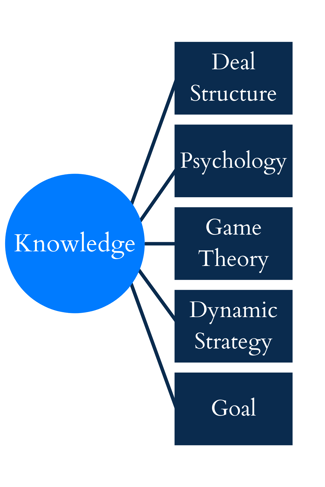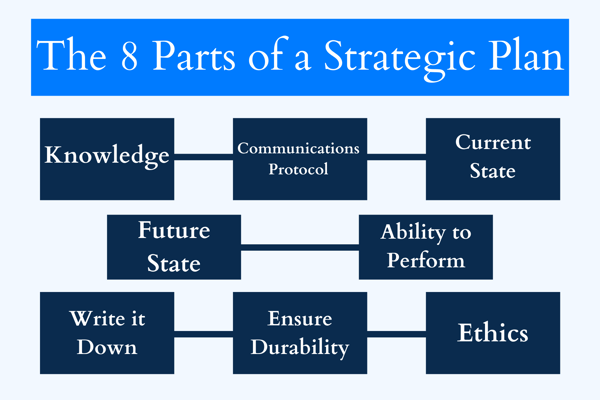This article highlights two basic rules of negotiations as well as how to create a plan.
Many times, new business owners are intimidated by the idea of negotiating, but it doesn't have to be that way! With confidence and knowledge, anyone can learn how to effectively and strategically negotiate with others. This article will highlight two basic rules of negotiations as well as an in-depth look at a negotiation plan.
Below are the two most basic rules of negotiation. These rules are important to keep in mind while interacting with other negotiators and making deals.
As negotiations are a form of human behavior, they are very predictable. Oftentimes you can predict or infer what the other party will want or say throughout the process. In order to get what we want, we as humans, use negotiation, persuasion, and influence. How effective we are at these three things will affect whether or not we get our needs met. Being able to anticipate human behavior in a negotiation will be very helpful, so keep reading to find out how.
A study from UC Berkeley and University of Pennsylvania produced the finding: “One of the most important attributes of a successful leader is the ability to negotiate effectively.” Oftentimes it is not enough to be a great leader only to your employees or yourself. You also need to be a great leader in dealing with external forces. Keep this in mind when reading the rest of this article.
The three main components of a negotiation are strategy, tactics, and operations. The first part is strategy, which is done before a negotiation and is the subject of this article. Tactics and operations are done during and after a negotiation. Learn more about them here.
About 80% of the time spent for your negotiation should be in preparation and strategy. In that way, it is often considered the most important part of negotiation. Remember, preparation does not mean changing your personality to fit what you think would be a good negotiator. You will perform best when you are yourself. Below, we will go through the eight elements of a strategic plan, so you can learn how to dominate a negotiation while still being yourself.
Five of the most important things to research and eventually know are your deal structure, your goals, general psychology, game theory, and dynamic knowledge. Knowing your deal structure and company structure will allow you to make informed decisions during a negotiation. Depending on how your company is set up and your business plan, different negotiation options could be helpful or harmful for you.

You should also have a grasp on your goals and expectations for the negotiation. An example of a clear goal is trying to keep a hold of your intellectual property (IP) when dealing with a new investor. Companies will have different IP policies, and some might want to keep theirs very protected. Setting a clear goal before a negotiation will allow you to have direct and clear mental instructions of what not to do.
An acronym that goes alongside this is BATNA. BATNA stands for Best Alternative to a Negotiated Agreement. This is also known as a walk away point. You will need to know your own walk away point as well as have a good idea of what the other party’s could be.
The third part of the knowledge step is understanding their (and your) psychology. An example of this is trying to categorize the other party into different personality types. When you do that, you may be able to ask specific questions or behave a certain way to accommodate their personality. The psychology of negotiation is recognizing that we are all human, and that we will all have different perspectives on a particular deal or trade. You can also use game theory and the math involved to better understand a negotiation. Game theory is all about competitive situations, just like a negotiations can be sometimes.
The last part of the knowledge category is dynamic knowledge. Dynamic knowledge is all about asking questions to overcome a new obstacle. You may not be able to plan the new obstacle, but you can be prepared if it does happen.
There are two elements to communication protocol: preference matching and control. Preference matching is facilitating and shortening the negotiation time by asking what type of communication they would like. Usually the best options are in person, over the phone, or through email. This will allow you to efficiently accelerate a negotiation by being on the same page, because both parties can agree.
In complex negotiations, you want to know who carries the information to the parties. This is called a Single Point of Contact (SPOC). Control protocol is about using the SPOC to your advantage by working around or with them. In general, the preference match works for more deal structures as opposed to the control method.
The third step in a negotiation plan is knowing your current state. This is critical because you need to be able to know you own current state to get the best option for your current position. Knowing your limits is important for any deal, and important to maintaining them. But, your current state is not only about your limits as a company. it is also about where you thrive and have room to grow.
This might require an audit for your company or the other. You want to be able to accept the deal you come to, and not find out that there is an issue later on.
Future state goes hand and hand with your current state. Future state is where you want to be after the deal is finished. What do you want to do after the negotiation? Where do you want your company to be, or not be? Future state is similar to your goals, but more broad. It is about your goals and expectations as an organization far past the negotiation.
Your future state needs to be communicated with the other party before a solution can be created. If you communicate where you see your company or product going, the other negotiator will be able to see how you can both benefit from the negotiation. You should also encourage them to communicate their future state as well, so you are able to do the same.
The fifth element is your ability to perform. This step is about asking yourself if you and the other negotiating party are able to make good on your deal. When assessing this, you need to consider three things:
Essentially, you are doing your due diligence on the other party. You want to ensure that you are making a good investment (and they should do this for you as well).
Writing your thoughts and agreements down in a negotiation is essential. You want to write down each thing that you agree on along the way as well as the final agreement. This will make it easier to structure a final contract or agreement because you will have smaller landmarks along the way to reference.
This technique also allows you to speed up a negotiation because you will not have to discuss things you have already agreed on. You are allowing yourself to move forward to the next issue sequentially. Writing them down in email is an effective way of organizing your agreements because both parties will have easy access to the same information.
Ensuring deal durability is asking yourself whether or not the deal will stand the test of time. Will it fall apart, or not? There have been studies done on what type of deal falls apart. It has been discovered that deals that feel ‘imposed’ on one party will fall apart more often than deals where both parties feel like they have contributed.
You can communicate deal durability to the other party after you have finished negotiating. An example could be, “I am glad we worked on this deal together and came to a solution that we both believe is best.” Making sure you use language like “we” and “both” is important to ensuring deal durability.
Are white lies ok in a negotiation? In short, no. If you do not get caught after telling a white lie, you may feel invincible. But, a small white lie can snowball into misrepresentation, which could lead to legal battles. Misrepresentation is withholding truth or lying in a negotiation or deal. Fraud is typically thought of a step above misrepresentation. That being said, spilling company secrets or protected IP is not the way to go. You can learn more about different types of IP here.
Instead, you should give facts related to the deal that you are legally able to reveal. Don’t be afraid of pauses in conversation; filling the void with excessive talking will do more harm than good.

Negotiating can be an intimidating part of the business world, but it doesn’t have to be. Coming prepared with a strategy is an important part of negotiation, and should be done well in advance of any actual meeting. You can use the 8 steps above to help you plan and remember key points of negotiation preparation. Remember, knowledge = confidence, so by doing your research on the deal and the different parties’ needs, you will be better suited to make a long lasting and beneficial deal.
This information comes from a talk with Martin Medeiros, ScienceDocs consultant in partnership with University Lab Partners.
Mr. Medeiros focuses on providing value to clients by solving their biggest problems and helps them avoid losses. At ScienceDocs, he helps entrepreneurs and startup companies with their most high-stakes and risky negotiations and counsels clients on the science of persuasion, influence and negotiation.
If you want to learn more about business planning, check out this article from ULP about SWOT analysis.
Be sure to subscribe to the ULP Youtube Channel to never miss another webinar, and connect with us on LinkedIn to stay in the loop!
Revised 9/8/2023
Download The Ultimate Guide to Wet Lab Incubators in Southern California, a handbook to assist life science start-ups through the entire decision-making process to find wet lab space.
Download Now